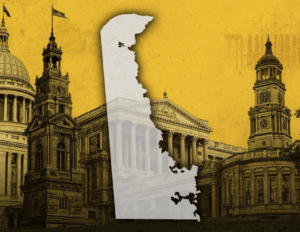Strap on those sparkly boots and grab your pom-poms, because America’s Sweethearts: Dallas Cowboys Cheerleaders just dropped its second season on Netflix! Everyone is swooning over the Dallas Cowboys Cheerleaders’ (DCC) killer dance moves and iconic star-spangled uniforms.
But beneath the dazzle, these ladies are fighting a gritty battle over wages and working conditions that’s anything but glamorous. From unpaid hours to questionable classifications and gender disparities, the DCC’s story exposes exploitation dressed up as “prestige.”
The “Privilege” of a DCC
America’s Sweethearts pulls viewers into the high-stakes world of the DCC, showcasing their grueling auditions, jaw-dropping performances, and sisterhood. The series highlights the cheerleaders’ dedication, with long hours spent perfecting routines like the signature kick line and jump splits, all while maintaining that “DCC look.”
These women are athletes, performers, and key brand ambassadors for a $10 billion NFL juggernaut, yet they’ve been paid at a level comparable to fast-food workers. Until recently, DCC members received $12-20 an hour for formal practices and events and $400 per gameday. Meanwhile, the Cowboys’ quarterback Dak Prescott rakes in $60 million a year, and even the mascot, Rowdy, was banking more than the cheerleaders. The team’s excuse? Being a DCC is an “honor.” Seriously?! You don’t see them telling players to tackle for the “privilege” of wearing the Cowboys’ uniform.
Wage and Hour Drama
As hourly employees, DCC deserve pay for every second they work under the Fair Labor Standards Act (FLSA). But America’s Sweethearts and the 2018 Erica Wilkins lawsuit dish the dirt: these cheerleaders are shortchanged. They’re paid for formal practices—recently upped to $75/hour for veterans post-2025 raise—but the rest? There’s still a lot that is expected outside of “working hours.” Here’s the rundown:
- Training Camp: The multi-week summer training camp involves 8–12 hours daily of rehearsals, fittings, and media training. While formal rehearsals are now paid, rookies may not be compensated until selected, and other camp activities, like team-building, often go unpaid.
- Independent Rehearsals: Cheerleaders spend hours outside formal practices learning routines at home or maintaining fitness, yet The New York Times and the series confirm this time is uncompensated, effectively lowering their hourly wage.
- Leadership Labor: Veterans mentor rookies and put in countless hours leading the team, but these extra hours are typically unpaid.
The 2018 lawsuit claimed unpaid hours sometimes dropped wages below the $7.25/hour federal minimum. The 2019 settlement bumped practice pay and covered some back pay, and a hard-won 2025 raise kicked it up. But independent practice and extra duties? Still unpaid. And that doesn’t even start to count the hours dedicated to maintaining that DCC look.
Part-Time Label, Full-Time Hustle
The Cowboys slap a “part-time” sticker on the DCC, dodging benefits like health insurance. But America’s Sweethearts spills that these women are grinding 30-40 hours a week during the season, with training camp pushing it higher. That’s full time in anyone’s book, and again fails to account for all the “extras” discussed above.
Misclassifying DCC likely violates the Affordable Care Act (ACA), which mandates health insurance for 30+ hour weeks. No benefits means most cheerleaders juggle second jobs to make ends meet. And P.S.—Those jump splits? They’ve sent some to the ER with no insurance to soften the blow. Yikes!
Gender Pay Gap
Sources like NBC News and America’s Sweethearts Season 1 cite $75,000 as the high end for veterans, but most cheerleaders likely earned closer to $20,000–$30,000 annually (well below a living wage for Dallas). Meanwhile, Rowdy the mascot pocketed closer to $65,000, and players like Prescott swam in millions. The 2018 lawsuit called this out, noting Rowdy’s $25–$30/hour trounced the cheerleaders’ $8–$12. This gender gap screams discrimination, potentially violating Title VII, which bans unequal pay for comparable work. These ladies bring in significant cash through performances, calendars, and global brand hype. Why have they not been compensated accordingly?
Make That Glitter Actually Shine: Lessons for Businesses
The DCC’s sparkle draws us in to America’s Sweethearts, but their fight against unpaid hours, misclassification, and gendered pay gaps brings important depth to the show and provides a wake-up call for businesses everywhere. The Cowboys’ fumbles offer hard-earned lessons to avoid legal and PR disasters:
- Pay for Every Second: Don’t skimp on wages for “expected” work like prep time or extra duties. The FLSA doesn’t mess around. Track all work hours and pay up, or risk a federal smackdown.
- Classify Employees Right: Calling full-time grinders “part-time” to dodge benefits is a risky game. The ACA’s $2,000–$3,000 fines per employee for missing health insurance hurt as much as those jump splits. If your workers clock 30+ hours like the DCC, give them the benefits they deserve.
- Close Gender Gaps: Paying women less for equal contributions isn’t just unfair; it’s a Title VII violation waiting to happen. Audit pay structures to ensure equity, especially for roles driving revenue. Fair pay keeps talent…and avoids social media wrath.
- Ditch the “Prestige” Excuse: Telling workers to toil for “honor” while pocketing profits is a PR disaster. The DCC’s $10 billion parent company learned this the hard way. Value your workers’ contributions with real compensation, not empty platitudes.
The DCC’s 2018 lawsuit and 2025’s 400% raise show progress, but unpaid hours and no benefits prove there’s work to do. Businesses, take note: treat your people like the stars they are—pay them fairly, classify them right, and ditch the excuses—or you’ll be dancing to the tune of lawsuits and bad press.




